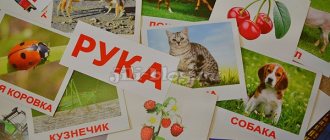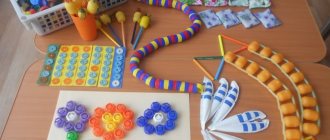Often, parents believe that there is no need to think about the development of the child’s speech if obvious pronunciation defects do not appear (the child has a lisp or does not speak at all). However, many problems in the future can be avoided, and a child’s literate and clear speech can be formed, if you start paying attention to speech development as early as possible throughout the entire period (before one year, and at one year, and at two, and at three...).
Speech development is not at all about working on individual broken sounds or expanding vocabulary, as is commonly thought. The formation of speech depends on the activity of many areas of the brain, so you need to work in all areas: develop fine motor skills, enrich sensory experience, work on articulation, breathing, increase vocabulary, and much more.
I have already written more than once about games that promote speech development in 1-2 years. In this article I would like to put everything together, and also publish many more useful exercises for articulation and breathing exercises and more.
So, games and exercises for speech development:
Finger and gesture games
Scientists have found that in the brain, the nerve centers responsible for the movements of the fingers and hands are in close proximity to the areas of the brain responsible for the development of speech. Therefore, it is simply necessary to promote the active actions of the baby’s fingers and hands. Wonderful helpers in this matter are finger games, I have already written about them more than once; a complete list of interesting finger and gesture games, sorted by age, can be found here:
FROM 1 YEAR
FROM 1 YEAR 3 MONTHS
FROM 1 YEAR 6 MONTHS
FROM 1 YEAR 9 MONTHS
In addition to funny rhymes, it is very useful to learn simple gestures with your baby in the meantime, for example:
- To the question “How old are you?” We show the index finger - “1 year old”;
- We shake our index finger “Ay-ay-ay”;
- We show “yes” and “no” by moving our heads;
- We show “thank you” with a nod of the head;
- To the question “How are you doing?” We show our thumb - “Wow!” ("Great!")
- We depict how the bear walks (feet shoulder-width apart, trampling from foot to foot);
- We depict how a bunny jumps (arms in front of the chest, hands down, jump);
- We depict how a fox walks (wiggle its butt);
- We depict how a wolf clicks its teeth (we open and close our mouth wide, clicking our teeth);
- We depict how a butterfly flies (waving our arms, running around the room);
- We depict how an airplane flies (arms motionless to the sides, we run around the room);
- We depict how a duck walks (we move on our haunches).
- As we approach two years of age, we begin to learn a new answer to the question “How old are you?” and we train to show the index and middle fingers at the same time - “2 years old”. The same finger figure can be called “Bunny”
Recommendations from a psychologist and speech therapist to parents
It is necessary to start learning from an early age; two years is a suitable period for the development of psychological processes and speaking through active joint activities. You can conduct classes with your child several times a day, at home, during a walk. To start the process of speech acquisition, you should follow a number of simple rules:
- Help the baby master the world around him. On the street (especially in the summer), talk more with your child about natural phenomena, what color the surrounding objects are, what are the names of animals running past, visit musical theaters, the circus.
- Develop fine and gross motor skills, engage in modeling. Today you can buy a variety of plasticine in stores: soft, kinetic, plastic, colored dough. Classes contribute to the development of mental processes and perseverance, which is reflected in the speed of speech acquisition.
- Teach your child the names of animals as they speak.
- Kids love to listen to adults read fairy tales and poems. It is a mistaken opinion that a child does not develop when he or she does not read a work independently. When listening, thinking, memory, perception, attention, and comprehension develop. It is important to ask your child questions while reading a fairy tale and discuss the characters. If the baby does not speak, the parents themselves show him an example: “Wow, what a cunning fox, huh?”
Sensory games to develop fine motor skills
A complete list of games for developing fine motor skills can be found here:
FROM 1 YEAR - PART 1, PART 2, PART 3, PART 4
FROM 1 YEAR 3 MONTHS
FROM 1 YEAR 6 MONTHS
FROM 1 YEAR 9 MONTHS
Articulation exercises
One of the very first and very useful articulation exercises that a one-year-old baby can handle is blowing. Tasya learned to blow at the age of 1 year 3 months, a candle helped us with this. As soon as we got used to the candle, we began to be able to blow into a pipe and blow soap bubbles. So, how can you master the blowing skill:
- Blow out the candle;
- Blow a pipe;
- Blow through a straw into a glass of water to make the water gurgle;
- Blow soap bubbles;
- Blow on a paper butterfly tied to a string to make it fly;
- Blow off small pieces of paper placed on a plate.
Here are some other articulation exercises you can practice (from about 1.5 years old, some things may work out even earlier):
- "Hide and seek." First we show our tongue - stick it out as far as possible, then hide it, repeat this several times.
- "Watch." Move the tongue from side to side - left and right.
- "House". We declare that the baby’s mouth is home. The mother gently taps her finger on the cheek: “Knock, knock,” and the baby’s mouth opens. We say: “Bye! Bye!” and his mouth closes.
- "Yummy". We open our mouth slightly and lick ourselves: first we run our tongue along the upper lip, then along the lower lip.
- "Balloon". We puff out our cheeks and burst them with our fingers;
- "Fence". We show our teeth (“bar our teeth”) and say that the tongue is hidden behind the fence.
- “Brushing our teeth.” We show the teeth again, then with the tip of the tongue we slide first along the upper teeth, then along the lower ones.
- "Horse". We “clop” our tongues like horses.
- “They made a mistake.” We stand together in front of the mirror and begin to express ourselves: smile widely, frown, stretch out our lips.
Features of practicing hissing sounds
To teach a child to correctly pronounce hissing sounds, you must first introduce whistling sounds. If a child in the fourth year of life has learned to pronounce whistling sounds, then there should be no problems with hissing sounds. You can install them with a few simple exercises.
- "Naughty tongue." The child sticks the tip of his tongue out of his mouth. Then he lightly slaps it with his fingers, while saying: “five-five-five.”
- "Delicious jam." The lower lip is pulled down so that the teeth are visible. And the tip of the tongue licks the upper lip, as if it is very sweet there. At the same time, the lower jaw should remain motionless during the exercise.
- “Hide the candy.” Mouth closed. Tighten your tongue and touch your left, then your right cheek. It's like there's candy hiding behind your cheek.
Repeat exercises at least 5 times.
Note! Producing the sounds of native speech is very important for children. It will help them not only make contact with their peers, but also better master the preschool and school curriculum. Parents have the power to help their children avoid difficulties in the future and put the sounds correctly in time.
Game "Who Lives in the House"
In my opinion, the game is great at encouraging children to pronounce simple sounds. In addition, the surprise moment in it increases the baby’s interest. So, in advance we put several story toys (animals, dolls, etc.) that are well known to the baby in a bag or box. Next, we ask several times “Who lives in the house?”, building up the intrigue. When the child is really interested, we take out the first character and say it together (and later the baby does it himself), for example, “Cow” or “Moo-moo,” depending on what stage the child’s speech is at. So, one by one, we take out all the hidden toys.
Poems that encourage the pronunciation of sounds and words
This is my favorite. Tasya and I simply adored these poems; my daughter tried her best to repeat simple words after me. The text in the poems is chosen in such a way that it motivates the child to talk. Even if the child does not repeat anything after you at first, this does not mean that the poems are useless. It is worth returning to them periodically, and the baby will definitely begin to try to repeat simple words and onomatopoeia.
How can we go for a walk? Top-top!
How do we close the door? Clap!
The cat comes to us from the porch: Jump!
Sparrows: Chick-chirp!
The cat is happy about the birds: Murr!
The sparrows took off: Furr!
Further with your feet: Top-top!
And now the gate: Clap!
How does the grass make noise? Shhh!
Who's running around in the grass? Mouse!
Bee on a flower: Zhu-zhu!
Wind with leaves: Shu-shu!
The river trickles: Rumble!
Hello, bright summer day!
***
A cow was grazing in the meadow: Moo, moo.
The striped bumblebee flew: Z-z-z, z-z-z.
The summer breeze blew: F-f-f, f-f-f.
The bell rang: Ding, ding, ding.
A grasshopper chirped in the grass: Tr-r-r, tsk-ss-s.
A prickly hedgehog ran through: Ph-ph-ph.
The little bird sang: Til-l, til-l.
And the angry beetle buzzed: W-w-w, w-w-w.
In the book “Chattering Poems” (Ozon, Labyrinth, My-shop) you can find many similar poems, although they are mostly a little more complicated than these two, but reading them will also have a very beneficial effect on the development of a child’s speech.
How does speech develop in children under 2 years of age?
Speech development occurs in stages, and each stage is present in any case , regardless of the nationality and language spoken by others. My child was no exception and went through all stages of speech development. Some stages lasted longer, some shorter, but in the end the child spoke fully.
- Scream. With my first child, I had a hard time understanding why my daughter was screaming, but with my second baby, I unmistakably learned to recognize when he was screaming from hunger or when he was just bored. From the moment of birth, the only way for a child to communicate with mom and dad is to cry. With it, he expresses feelings of hunger and thirst, physical discomfort, draws attention to himself if he is hot or cold, clothes are tight or uncomfortable, and also if the baby is in pain. Attentive parents can also quickly learn to distinguish between different types of crying.
- Booming. From about 3 months, newborns begin to hum: most often this happens when the baby is happy and thus expresses a feeling of satisfaction. However, this period does not have to coincide with the beginning of the party. My first daughter began to walk only at 4.5 months, being completely healthy and without any deviations, but my son was already walking and singing in every way at 2 months. The child learns to move his tongue to pronounce sounds and trains the speech apparatus in every possible way. The buzz is usually reproduced in the form of the words “Agu”, “Ua”, “Gaaa”, “Guuu”.
INTERESTING! All nations of the world have children who walk in exactly the same way.
- Pronunciation of syllables and babbling. By about 7-8 months, children can pronounce different syllables, and they are not yet associated with certain images and words. The baby may say “Ma-ma-ma-ma-ma” without meaning his mother at all. However, this is an important stage in which the child masters the main part of sounds.
- First words. At the age of one, my first child could only say so much: “baba”, “dad”, “yum-yum” and a couple more phrases from his personal repertoire that cannot be translated into human language. By the age of one year, a baby can know and pronounce up to 10 words. Moreover, these may not always be full words. For example, instead of the word “dog,” a child may still say “Woof-woof,” which in his mind is associated with a specific image. It is also acceptable to pronounce truncated words, for example, “kava” instead of “cow”.
- Conscious speech. By the age of two, a child usually has a certain set of words that, at the very least, he can communicate with adults. Usually this vocabulary is enough to call mom and ask for a toy. It is considered normal if a child speaks about himself in the third person: “Masha is playing” instead of “I am playing.” It is from this stage that speech will rapidly develop every day, and the vocabulary will fill up.
Breathing exercises
(from about 1.5 years old)
- The wheel burst. First, we clasp our hands in a circle in front of us, depicting a wheel. Then, as you exhale, we begin to slowly cross our arms (so that the right hand rests on the left shoulder and vice versa) and say “sh-sh-sh” - the wheel deflates.
- Pump. Next, we invite the child to pump up the deflated tire. We clench our hands in front of our chest into fists, as if we were holding a pump. We lean forward and lower our hands down, accompanying our actions with the sound “ssss”, repeat several times.
- Loud quiet. We pronounce a sound loudly and quietly. For example, first we pretend to be big bears and say “Uh-uh,” then we pretend to be little bears and say the same thing, only quietly.
- Woodcutter. First, we put our hands together (as if we were holding an ax) and raise them up. Then we sharply lower them down, bending over and saying “uh.” We repeat several times.
- Wizard . First, we wave our hands and hold them at the top. Then we smoothly lower it, pronouncing the syllables: “M-m-m-a”, “M-m-m-o”, “M-m-m-u”, “M-m-m-y”.
Reading books
While reading, it is advisable to constantly use the questions “What is this?”, “Who is this?” (even if you have to answer them at first), questions activate the child’s mental detail and encourage him to talk.
Well, what is the best thing to read to a child at this age, you can find out here:
A SELECTION OF BOOKS FOR CHILDREN AGED 1-2 YEARS OLD. TALES AND POEMS
DEVELOPMENTAL BOOKS FOR CHILDREN 1-2 YEARS OLD
What measures to take in case of ZRR?
If you suspect your baby has a delay in speech development, do not put off visiting a specialist.
It is important to take timely measures, since this problem has a steady increase in dynamics, which will subsequently lead to the formation of a delay in psycho-speech development (DSRD) in the child.
Some parents mistakenly believe that speech therapists treat mental disorders. But they will only teach the child to speak various sounds, make sentences orally, and conduct speech therapy massage of the speech apparatus to improve diction.
In case of mental retardation, in addition to a speech therapist, you will need to consult the following specialists:
- neurologist;
- speech pathologist;
- child psychologist.
Only a specialist will be able to identify the problem, if any, and prescribe the correct treatment.
Role-playing games
Role-playing games are a very fertile environment for speech development. During the game, a child has a natural need to say something: he needs to somehow name the main characters of the game and their actions, express his thoughts and feelings.
Read more about how to play role-playing games with a 1-2 year old child here.
Reasons for rejection
A child becomes non-verbal as a result of not only psychological disorders. The social environment plays an important role in the development of speech. If parents do not talk to the baby from birth, do not spend time together playing games, and the baby is left alone with himself in the sandbox during a walk, RDD may occur. It is more difficult to learn speaking if there is no communication with other children, people other than mom, dad, and grandmothers. It is easier to teach speech when the child enjoys playing together. If parents have chosen the wrong, uninteresting development program, the baby may be lazy to study and not be active.
Psychologists say that speech delay often occurs as a result of the child’s character traits, which is not a negative factor. Parents should not force a child who is shy and timid to speak. A one-year-old boy or girl can be sociable and active, play with other people and children, and upon reaching the age of two, become modest and unsociable. This is due to age characteristics, the crisis of 3 years of age, when the baby begins to divide adults into “us” and “strangers”. Heredity plays an important role. If mom or dad started speaking late, the child repeats the speech behavior of the parents in 70% of cases.
The provoking factor for the development of mental retardation is the lack of need for speaking. Moms and dads love to fulfill the child’s requests the first time, sometimes the baby doesn’t even say the wish, he points with his finger, “moos.” Parents guess what the baby needs without words and fulfill the request, which is wrong. The child lacks motivation to speak when he is already understood. If the baby points with his finger and does not want to speak, psychologists advise saying: “I don’t understand what you want, tell me,” more often to provoke situations that complicate the child’s activities without language.
Among the pathological causes of FGR are:
- Neurological disorders.
- Somatic pathologies.
Viewing Doman cards or other material that expands a child’s horizons
I really love the Doman method - not the one in which parents chase results and the child sees nothing else except cards, but the version where parents show the child really interesting information without fanaticism. With this approach, the child loves the cards and looks at them with pleasure. He also tends to repeat the words he heard while watching!
During my lessons with my daughter, I noticed many times that her favorite cards encouraged her to say more and more new words. At the age of about a year, Taisiya tried, at least in monosyllables, to repeat after me the name of the picture she saw, or to depict it (for example, she snorted at the sight of a hedgehog, or pointed to a specific object). A little older, she began to repeat all the words in their entirety. Well, at 2 years old, when it was time to study fact-sentences, she easily memorized them and then gave them to us.
I don’t think it’s even worth talking about the fact that viewing Doman’s cards expands a child’s passive vocabulary.
Stages of speech development
- Preparatory, or passive. It begins when the child is born and ends when he is 1 year old. At this time, the baby reacts to communication, understands where the sound is coming from, and is ready to play.
- Pre-school, or autonomous. Starts when your son or daughter turns one and ends at age 3. The first sounds and words are not yet entirely clear, but the baby is already trying to form phrases. At this time, vocabulary accumulates. The child understands words and uses them.
- Preschool or active. While a child is preparing for school, his speech is actively developing, and the number of people with whom he communicates increases. The baby can already speak coherently, clearly and comprehensively. Speech becomes a means of understanding the world around us.
- School. The most important, responsible and serious period of speech development. By the age of 18, a child learns the basic rules of grammar, punctuation, and spelling. At this time, it is no longer oral speech that develops, but written speech. The student begins to master literary speech. In addition, he develops a certain slang associated with his age and the company in which he is located.









